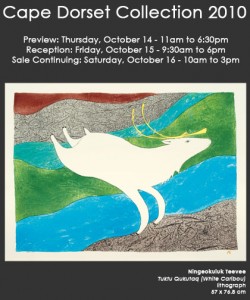Changing Art in the North: A reflection of social and environmental realities
Since the 1950s, Cape Dorset or Kinngait, the “Capital of Inuit Art” has been a centre for drawing, printmaking and carving. Today, printmaking and carving are the community’s main economic activities. But some older artists along with younger ones are creating art of a different nature, art that is less known and less valued in southern Canada – art that reflects the artists’ changing social and environmental context. The video “The New Raw” focuses on this situation.
The New Raw
Video 11 min. Radio Canada International (RCI)
Interviews with Cape Dorset artists and footage of their art inform the viewer of the diversity of northern art. The viewer hears that southern Canadian art lovers still seek and maintain the demand for Arctic art with traditional images – the animals of Inuit legends – but there is a growing number of Cape Dorset artists who produce art reflecting the social and environmental change of their day-to-day realities.
http://eyeonthearctic.rcinet.ca/en/video/video-categories/viewvideo/59/art-and-culture/the-new-raw
See also these RCI videos:
The Rebel – Jutai-Toonoo, 26 min.
http://eyeonthearctic.rcinet.ca/en/video/viewvideo/60/art-and-culture/the-rebel-jutai-toonoo
The Up-And-Comer – Ningeokuluk Teevee, 8 min.
http://eyeonthearctic.rcinet.ca/en/video/viewvideo/64/art-and-culture/the-up-and-comer-ningeokuluk-teevee
The Carver – Toonoo Sharky, 8 min.
http://eyeonthearctic.rcinet.ca/en/video/viewvideo/61/art-and-culture/the-carver-toonoo-sharky
The Printer – Niveaksie Quvianaqtuliaq, 7 min.
http://eyeonthearctic.rcinet.ca/en/video/viewvideo/62/art-and-culture/the-printer-niveaksie-quvianaqtuliaq
Note: In this video we see the making of the print of “Stiletto,” an example of a more modern stone cut art piece by Kavavaow Mannomee.
November 19, 2010 No Comments
Canadian Roots/Shielded Minds
http://shieldedminds.ca/canadianroots/
I found this link to be an interesting project by non-Indigenous youth to build relationships with Indigenous peoples. These youth are fed up with the stereotypes and the lack of effort by the government to build the bridges between the cultures, so they have taken matters into their own hands. They set out on a road trip to learn, understand, share and build relationships, and they created a documentary about the trip. The trailer describes their purpose but I don’t see any screening information on the full documentary. It appears that the road trip was very successful, so they have started a program to continue these trips. The trailer offers hope that students will not accept the status quo and have decided to start effecting change themselves.
November 8, 2010 No Comments
National Aboriginal Day: Our Voice, Our Culture, Our Community, Aboriginal Youth Video Project
Twelve young people from Richmond, BC were taught how to create a video story. They created this video of their experiences as young Aboriginal people living in Richmond. They were encouraged to include footage and reflections on National Aboriginal Day in Richmond, as well as reflect on their history and current issues. The theme follows the two videos we viewed in module 3.
November 8, 2010 No Comments

